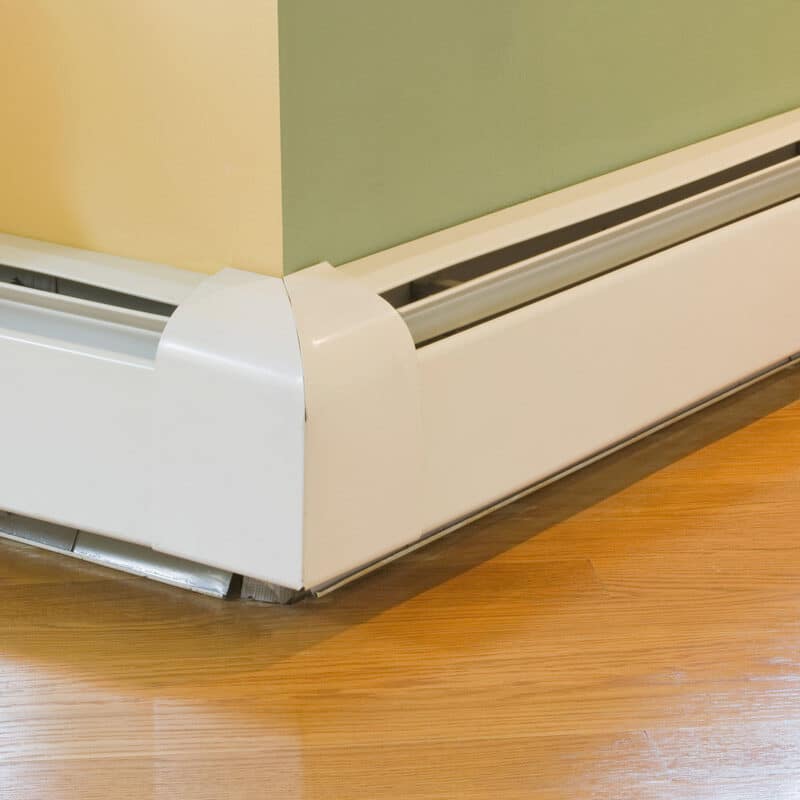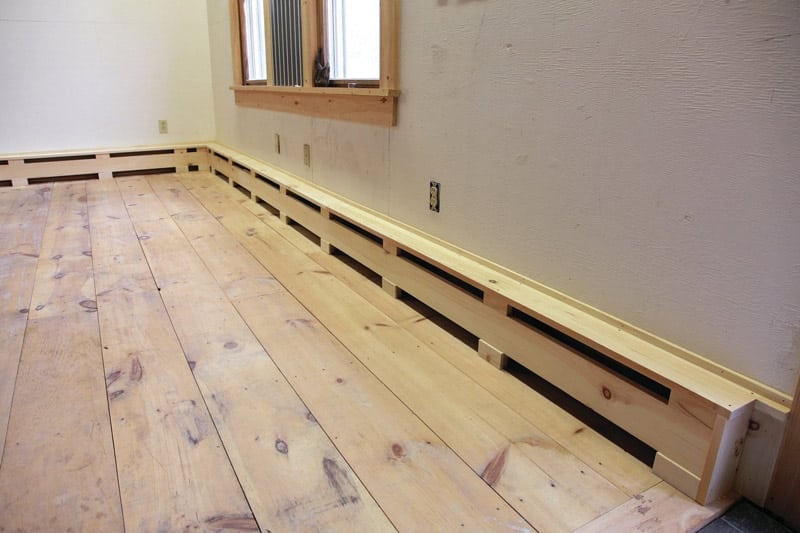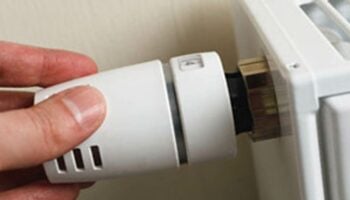We've independently reviewed this article to make sure it's as accurate as we can make it.
To find out more about our article creation and review process, check out our editorial guidelines.
Brrr, it’s chilly… time to turn up the heat! Are you trying to decide whether you should install radiators or baseboard heaters in your home? Then check out the comparison coming up in this article.
These are some of the main differences between radiators and baseboard heaters:
| Radiators | Baseboard Heaters |
| -Heat objects through radiation -More efficient -Heavier -More expensive -More complicated to install | -Heat the air through convection -Less efficient -Lighter -Cheaper -Easier to install |
Installing a new heating system is a big decision and one that we’re all keen to get right the first time around. To find out whether you will be best with a radiator or a baseboard heater, take a look at the complete comparison coming up next.
Introducing Radiators and Baseboard Heaters
Installing radiators is a great method of heating your home. They heat through radiation, are efficient, and compact. There are also a bunch of cool accessories that you can add to your radiator to make it even more efficient and easier on the eye. In the upcoming comparison, we’ll discuss all of your options.

Installing baseboard heaters is also a fantastic option for heating. They use convection heat to keep things warm and are lightweight and cheap to install. What more could we ask for? So, now that we’ve broken the ice, let’s jump right to the comparisons.
The Difference Between Radiators and Baseboard Heaters
Radiators and baseboard heaters are heating systems that you can install at home. But aside from that similarity they differ in just about every other category. Here are the specifications that we will compare in this article.
Heating Method
To start the ball rolling let’s look at a factor that sets radiators and baseboard heaters apart. That is, the heating method that they use.
Radiators transfer heat to objects using a radiation heat method. This helps the objects to warm through and then raise the temperature of other objects. Objects hold onto heat better than air. This makes the atmosphere feel warmer for longer even after you turn a radiator off. Let’s see how the heating process works for various types of radiators.
- Cast iron radiators warm up by burning fuel to heat the water that pumps to your radiator
- Steam radiators operate similarly to cast iron radiators. The only difference is that they use pressurized steam instead of pumps.
- Electric radiators work with specialized heating elements. These elements transfer heat to objects using radiation.
Baseboard heaters heat the air using a convection heat method. They heat the particles in the air making you feel warmer faster. They do not heat objects, so once they are off, you will cool down quicker than you would with a radiator. If you open a door to the outside world, the warm air will quickly dissipate because heat transfer always works from hot to cold.
But how do they operate? Baseboards contain either oil or water which warms up using a heating element. This element warms the air above and around the baseboard.
If you are looking for a heater with the best heating method, you should choose a radiator.

Efficiency
It is also important to consider efficiency when installing a new heating system. Although a system may have a low installation cost, that does not mean that it will have low operating costs. So, which system is most efficient for you to run?
Radiators are more efficient to run. This all links back to the way that they disperse their heat. Since they heat objects rather than the air, the room stays warmer for longer and holds its heat better in the face of cold air. This is because objects hold onto heat.
Baseboard heaters, however, are less efficient to run. This is due to the fact that they heat the air rather than objects and the air loses its heat faster. Heat always transfers from hot to cold. So, if cold air is introduced to a room with baseboard heaters, you will quickly feel the difference. This is why you have to keep a baseboard heater on intermittently in order to feel the benefit.
If you are looking for the most efficient heater, you should choose a radiator.

Weight
Are you thinking of installing your heating system yourself? Then knowing how much weight you’re up against is important. What is the weight difference between radiators and baseboard heaters?
Radiators are heavier than baseboard heaters. This is because some radiators are made of cast iron which is a sturdy and heavy material. Once a radiator begins working it fills with fluid. This again adds to the weight of the unit.
Baseboard heaters are a lot lighter than radiators. This makes them easier to install. But you will need a larger number of baseboard heaters to make up a heating system that is as powerful as a radiator.
Let’s take a closer look at just how much these two compare in weight.
| Radiator | Baseboard Heater |
| One cast iron radiator can weigh between 40 and 150 pounds (ca. 68 kg) | One 7-inch by 2.5-inch baseboard heater weighs roughly 10.5 pounds (ca. 5 kg) |
If you are looking for a lightweight unit, you should choose a baseboard heater.

Price
Installing any kind of heating system in your home will cost you a pretty penny. But which type of heating will do less damage to the piggy bank?
Radiators are more expensive to buy and install than baseboard heaters. But they are cheaper to run as they maintain their heat better than convection heaters, and you do not need to leave them on as long.
Baseboard heaters are cheaper to buy and install than radiators. You could pay as little as $7 per foot for a baseboard heater! This is because of the simple components that baseboard heaters are made of, mainly, metal and copper. But they are more expensive to run as they have to continuously turn on and off when the heat in the air cools down.
Let’s look at a comparison of these two prices:
| Radiator | Baseboard Heater |
| Costs between $300 and $1,200 for new installation and parts (provided you have a suitable hot water heater or boiler already!) | Costs between $400 and $650 for new installation and parts |
If you are looking for the most economic deal, you should choose a baseboard heater.

Ease of Installation
What about installation? Which is easier to install, a radiator or a baseboard heater? Let’s find out.
Radiators are harder to install than baseboard heaters. This is because they are heavy and need mounting. They also require professional plumbing to ensure that the unit works properly.
Baseboard heaters though are extremely popular amongst homeowners because they are easy to install. You could DIY install your own baseboard heater and have them up and running in next to no time.
At least, this is true for electric baseboard heaters. You can also get water-based baseboard heaters called Hydronic baseboard heaters. These are a lot more complex to install, similar to radiators.
If you are looking for a heater that is easy to install, you should choose an electric baseboard heater.
Can You Replace Baseboard Heaters With Radiators?
Are you planning on changing the heating system in your home? What if you want to replace a baseboard heater with a radiator? It is possible to replace baseboard heaters with radiators. However, this is not a simple job. To complete it, you will have to do the following:
- Repipe above the floor to move the pipes closer together. (This is to accommodate the installation of a radiator.)
- Floor repair (if you decide to recess the radiators)
- Wall repair (if you decide to recess the radiators)
- Install larger circulator pumps. (This is necessary as you will be moving larger volumes of water with a radiator than you did with a baseboard heater.)
Conclusion
So which option comes out on top? If you are thinking about changing the heating system in your home, should you install radiators or are you best off installing baseboard heaters?
You should install radiators if:
- You want a heater that dissipates its heat via radiation
- You are looking for an efficient heater
You should install baseboard heaters if:
- You want a heater that dissipates its heat via convection
- You are looking for a lightweight heater
- Finding the most economic deal is important to you
- You need a heater that is easy to install
If this article has helped you, please consider supporting us by checking out some more of our free guides. You could even sign up for our e-mail list.
Thanks for reading, and have a great day!
— Craig.
Frequently Asked Questions
How Do I Maintain a Baseboard Heater?
The best way to keep a baseboard heater in good condition is to clean it regularly, remove debris (when it’s completely cool), check its connections often, and get a professional to take a look at it once every couple of years.
What’s the Average Lifespan of a Radiator?
Radiators are known for being quite durable, as the average unit can last anywhere between 10–15 years.
This, of course, if you maintain it frequently, use it according to your manufacturer’s instructions, and repair it whenever you notice something’s wrong.
Can Baseboard Heaters Be Used With Solar Panels?
Absolutely, but with certain considerations.
While, on paper, there’s nothing wrong with using this appliance with a solar panel, you should always check your User Manual and follow your manufacturer’s instructions to prevent any issues.







